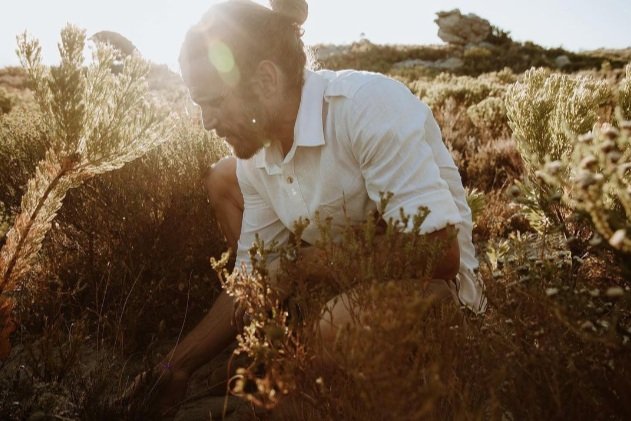From Flora to Fine Metal: Exploring the Botanical Artistry of Nic Bladen
Written by Carolyne Wamono

Cape Town sculptor Nic Bladen has gained worldwide recognition for his exceptional botanical sculptures and jewellery, which beautifully celebrate the nuanced and diverse beauty of the plants that grace his native Western Cape, South Africa. Serving as a captivating bridge between two worlds—where art seamlessly intertwines with nature—Bladen has skillfully carved a niche for himself by harmoniously blending organic beauty with the timeless allure of fine metals. The start of his distinctive approach, involving the meticulous casting of plants, traces back to an unexpected journey that blossomed into a thriving studio. Today, his creations find homes in both public and private collections across the globe, proudly represented by the esteemed art gallery Everard Read.
Journey: Precision and Attention to Detail
Bladen’s artistic journey began in a field seemingly at the opposite end of the art spectrum — as a dental technologist. Unaware that this disparate career path would eventually lead to the establishment of Nic Bladen Botanicals, he spent eight years crafting gold and porcelain crowns in various dental laboratories across South Africa and the UK. This discipline demanded unwavering focus, laser-sharp precision, and acute attention to detail. He experimented with casting flowers on the side, but these creative endeavours remained a personal pursuit until 2000 when he met Otto du Plessis at Bronze Age Foundry in Simon’s Town. Under du Plessis’s tutelage, he began working, learning large-scale bronze casting and all aspects of metalwork, laying the foundation before venturing out on his own.
Merging Expertise in Dental Technology with Bronze Casting
Bladen pioneered a distinctive method for preserving plants by merging his expertise in dental technology with bronze casting. His artistic journey began with the creation of botanical jewellery, casting intricate leaves and flowers. A significant turning point occurred when the president of the local orchid society approached him, seeking the casting of entire orchids in bronze.
This moment marked a pivotal shift for Bladen, propelling him onto a botanical path that has led to his current standing—exhibiting in the Everard Read Gallery in both London and across South Africa, and operating a workshop in a heritage building in Simon’s Town, before relocating to Kommetjie, where the studio is today.

Process in Bloom: Botanical Impressions through Metal Casting Mastery
Bladen's process begins with a simple walk to find or gather plant cuttings. He utilises the ancient technique known as ‘lost wax’ casting or cire perdue, where a plaster mould is formed around a wax pattern. The wax melts away in a kiln, leaving a cavity subsequently filled with molten metal. Departing from the traditional use of wax, Bladen employs flowers, leaves, and seedpods. The plant, acting as the mould, is burned off, leaving behind a cavity which is then filled with solid metal, resulting in a faithful reproduction of plant to the most minute details. The creation of the enduring sculpture requires the destruction of the transient plant resulting in a unique piece.
Despite its apparent simplicity, challenges arise in the form of cracked moulds or unforeseen holes, emphasizing the need for precision and focus in each step of the process. Bladen stresses the importance of humility and attention to detail, recognizing that even a small oversight can impact the entire creation.

Preserving Nature's Legacy: Bladen's Artistic Tribute to the Cape Floral Kingdom
The casting process, an innovative technique for preserving and fossilising plants and flowers, echoes the artist's core message—the preservation of nature. Inspired by the Cape Floral Kingdom, the smallest but richest of the world’s six distinct floral regions, Bladen draws from his lush surroundings but is deeply disturbed by the degradation of the environment and the increasing numbers of endangered plants. He expresses his love for and celebration of Southern African plant diversity through numerous exhibitions:
Nic's first solo exhibition, held at the Everard Read Gallery in Cape Town in 2013, showcased the botanical richness of the Cape Peninsula, featuring rarities such as the Blue Disa, the endemic Serruria villosa, and others, thanks to concessions from peninsula landowners.
Focused on South Africa's diverse plant family, casting about 10% of the approximately 360 species, portraying seven of the fourteen genera, represented by thirty species. The exhibition included a comprehensive catalogue documenting the habitats, distribution, and conservation status of each bronze plant casting.
The act of casting takes on a symbolic role as Bladen showcases endangered species from private holdings to the public realm. Bladen's bronze and sterling silver botanicals become metal fossils, as he captures rare plants in profound detail carrying a timeless message about the urgency of protecting endangered species, especially in the face of global warming.






